It has been well demonstrated that jails and prisons are incubators and amplifiers of diseases and infections because of the tight quarters of correctional facilities. This makes combatting the Coronavirus through “social distancing” and other measures nearly impossible. To that end, West Virginia has taken some measures to slow the spread of the Coronavirus within our incarceration system by reducing the inmate populations but more needs to be done if we are going to “flatten the curve” and protect those inside and outside of our correctional system.
Since Governor Jim Justice declared a State of Emergency in response to the COVID-19 pandemic, the state and the WV Division of Corrections and Rehabilitation (DCR) has taken some emergency policy measures regarding correctional facilities, including testing, quarantining, and the release of some inmates to reduce population density. Specifically, the WV Supreme Court has asked circuit judges and county magistrates to work with prosecutors to identify low risk pre-trial inmates, those serving short jail terms for parole-related sanctions, and work-release inmates that are already eligible for weekend furloughs.
Since the implementation of these COVID-19 emergency policy responses from DCR, the state has seen a sharp decline in the average daily inmate population in regional jails, state prisons, and work-release facilities. Over the last two months the average daily inmate jail population declined by over 1,000 or 21 percent from the beginning of March to the end of April. Comparing these figures to annual statistics reveals that the number of inmates in our state’s 10 regional jails is at a ten-year low (see chart below).
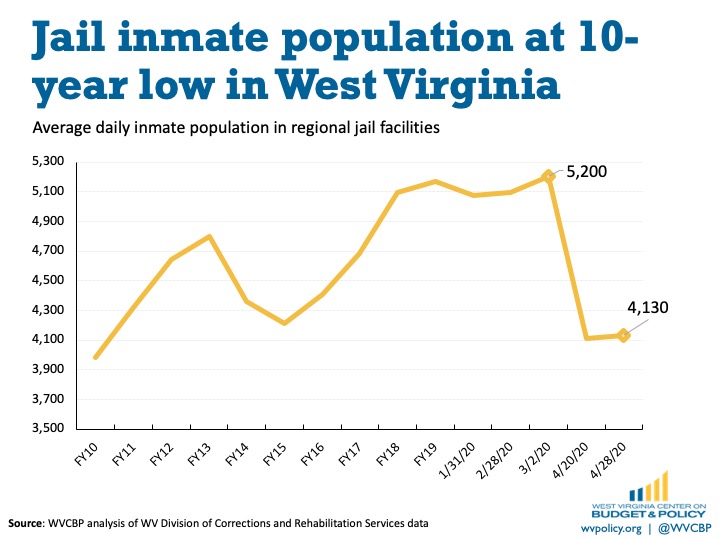
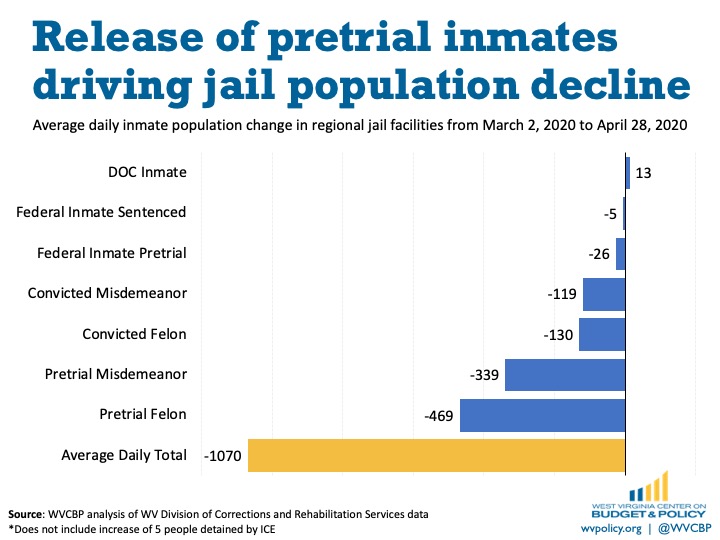
As the chart above highlights, approximately three-quarters of the decline in the jail inmate population has been driven by a reduction in pretrial detainees. There appears to also be a sizable drop in inmates that have been convicted of misdemeanors and felonies. While female jail inmates make up about 18 to 20 percent of the jail population, they made up about 30 percent of the decline in the daily inmate population. Over the last two months, women accounted for 317 of the drop in jail incraceration while men accounted for 753 (70%).
There has also been a decline in the state’s prison population, however the number of inmates sentenced to prison but housed in jails due to prison overcrowding has remained virtually unchanged. The majority of the prison population reduction has been concentrated at the state’s non maximum security prisons.
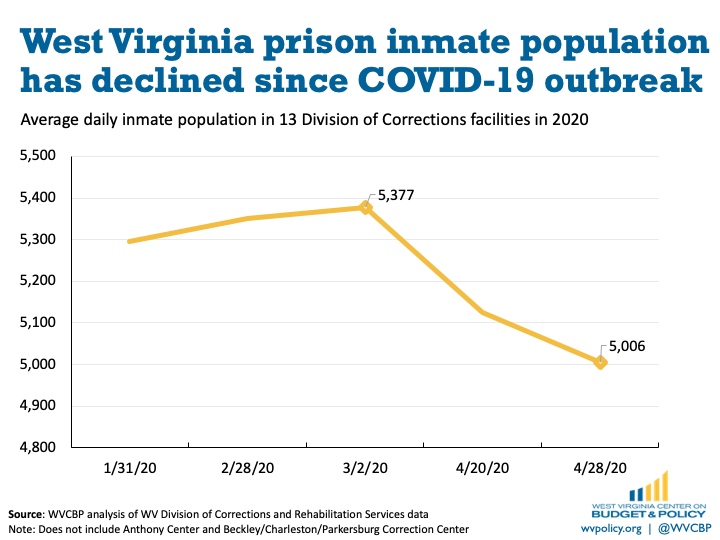
Since March of 2020, the state’s prison population has declined by 6.9% or by 317 inmates. This includes 304 males and 67 females inmates. The largest decline by institution was at the state’s only female prison (Lakin), which declined from 585 inmates in March of 2020 to 516 at the end of April 2020. The state’s maximum security prison, Mt. Olive Correctional Complex, did not see a reduction in the inmate population between March and the end of April 2020.
The number of prison inmates at the state’s three community corrections centers has also declined by 100 from early March to late April of 2020. The WV Department of Corrections have stated publicly they are “considering whether to furlough inmates that pose no safety risk, including those nonviolent, those that are 60 and older, those 90 days or so from end of sentence, and those pregnant….”
The number of inmates on work release (furlough) has also grown. Inmates on work release ‘furlough’ have more freedom and many have the ability to go home on weekends. ‘Out to work’ work release inmates are allowed to have jobs but are more closely monitored Between March 2nd and April 28th of this year, the number of ‘out to work’ inmates was eliminated while the number of work release furloughs increased from 5 to 122.
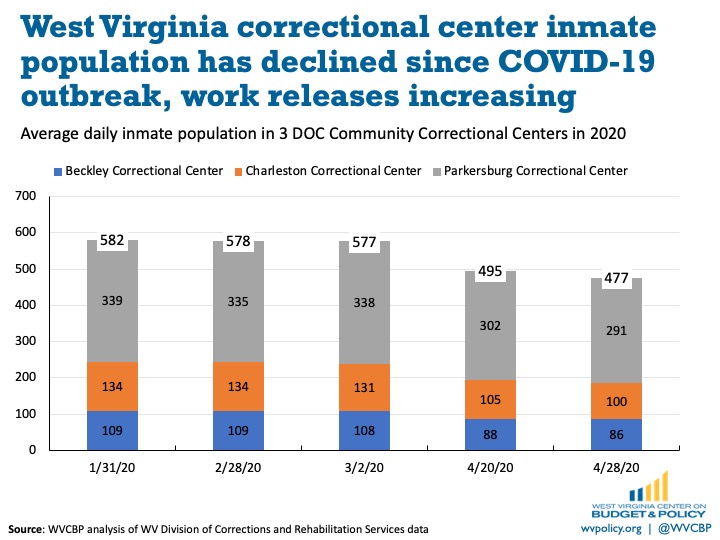
The number of youth in the ten Division of Juvenile Service (DJS) facilities has only experienced a small decline (4.8%) over the last two months, from 253 to just 241. Over this time, the number of females in DJS facilities has increased from 38 to 55 from the end of January to the end of April of this year. Females now comprise 23% of the DJS population, compared to just 10% in the state’s adult prison system and 16% in regional jails.
Similar to the state’s prison and regional jail system, there are large disparities by race and ethnicity. Among the 241 youth in DJS facilities at the end of April 2020, almost 27 percent (67) are categorized as not being white, with the largest share being Black Non-Hispanic (35). In 2018, white-non-hispanic youth made up 89% of the state’s under 18 population but comprise 73% of youth in DJS facilities. For comparison, white residents made up about 86% of the adult jail and prison population.
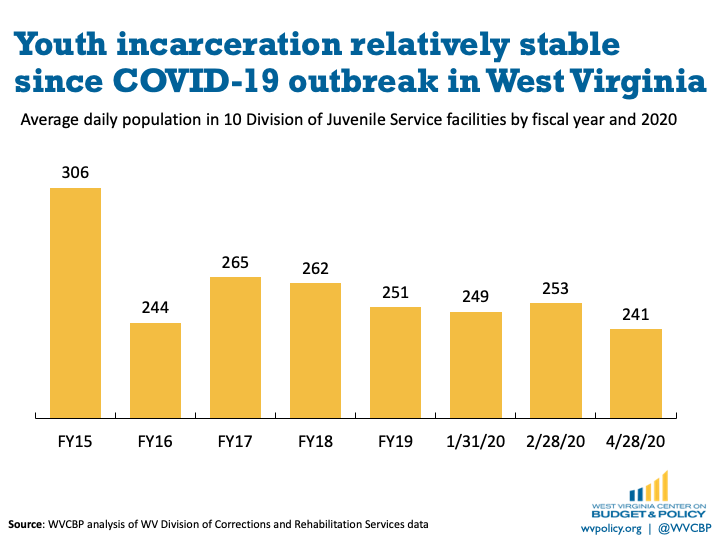
While reforms after the COVID-19 outbreak have led to sizable reductions in the state’s incarceration system, it is imperative that more action is taken continue to pursue steps that reduce admissions and increase releases from the more than 11,000 people locked up in our state. This should also include efforts to reduce racial and gender disparities and the high costs of high mass incarceration in West Virginia.
As West Virginia looks for ways to cut costs from the plunge in state revenues as a result of this pandemic, it should continue to reduce the level of incarceration in the state by restricting or refusing admissions from technical parole violations and reducing arrests for petty offenses. Policymakers can also build upon decarceration efforts by releasing people that are near the end of their sentences, those who are medically fragile or over 60 years old, pregnant women, and others that pose little risk if released.